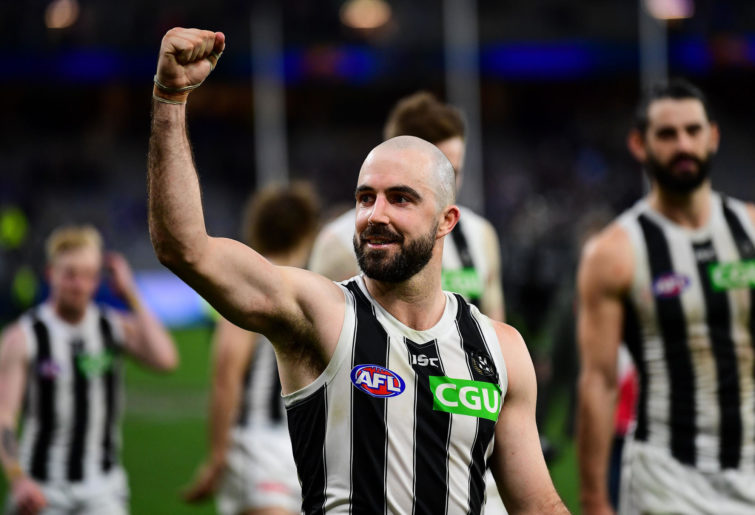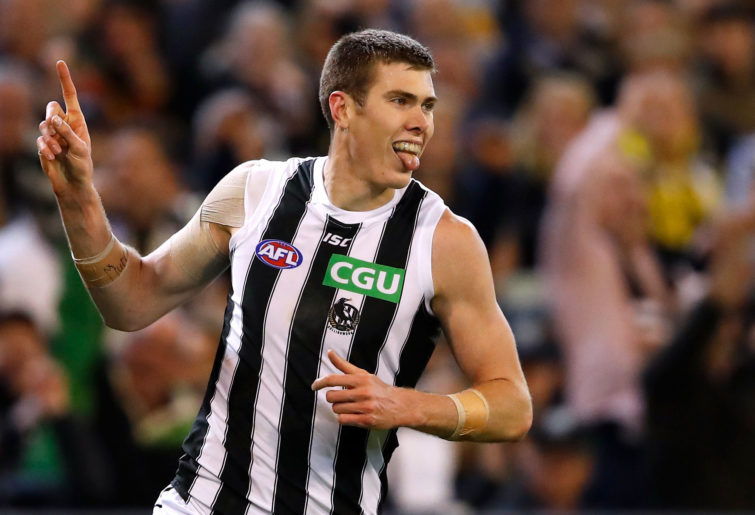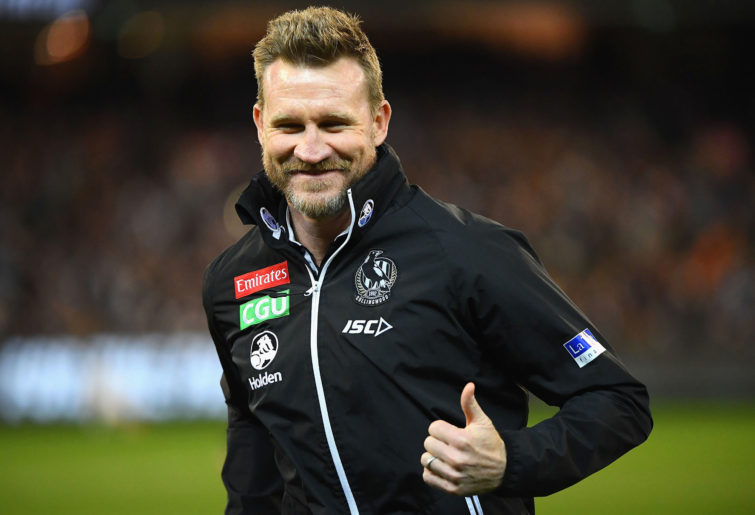In 2018, Collingwood fell agonisingly short of a flag. In 2019, they never truly seemed to get going, and yet still made a preliminary final.
The query is where do they go now? In a competition with such volatile shifts, Collingwood could make another grand final, or just as easily drop out of the eight.
If Collingwood are to move forward, here’s nine things I want to see from them in 2020.
9. Get the midfield right
Going into 2019, Collingwood’s midfield was lauded as formidable. But even with the addition of Dayne Beams, I just didn’t see it.
Scott Pendlebury is sublime, but is entering the twilight of his career. Queries about disposal hung (and still hang) over Adam Treloar and Taylor Adams. Steele Sidebottom is struggling with hard tags. Brayden Sier, Rupert Wills, Callum Brown and Tom Phillips are still works in progress. And even before Dayne Beams’ misfortunes, you still had to factor in he was a 29-year-old mid who’d spent his career using his body as a battering ram.
Too often – and exacerbated by Taylor Adams’ prolonged absence – it just felt as if midfield didn’t click. The chemistry was wrong. Adam Treloar was getting too tangled up in congestion feeding out ankle-breaking handballs, rather than breaking lines. Sidebottom was lost, doing a lot of running but having little impact. The younger players were inconsistent. The onus kept falling on Scott Pendlebury, who – at his age – should be complementing the midfield rather than still leading it.
As good as Jordan de Goey and Jaidyn Stephenson are up forward, their class and explosiveness need to be injected into a midfield that is decidedly one-paced and predictable. There’s not much use waiting for the ball up forward if it’s not coming down, or coming down haphazardly because the midfield is under such pressure.
8. Move Steele Sidebottom up forward
With no disrespect intended to Steele Sidebottom, I just don’t see him as an elite midfielder. Nat Fyfe is elite. Patrick Cripps is elite. Would I band Sidebottom with those players? No.
I’d classify Sidebottom as a very good midfielder who capitalises on a functioning engine room, and when that’s happening it pushes him up onto the boundaries of elite. When the engine room is spluttering (hello, 2019!), he gets lost on the outer.
But I do classify Sidebottom as a potentially elite forward. Around goal, Sidebottom plays with temerity he doesn’t display as a mid. He takes tacklers on. He converts half-chances. His dual-sidedness and goal nous makes him a dangerous prospect who could kick 50 goals.
Moving Sidebottom up forward would also allow de Goey and Stephenson to spend more time on the ball.

(Photo by Daniel Carson/AFL Photos via Getty Images)
7. Get Brodie Grundy’s tap work right
It galls me that it took the 2019 preliminary final for the footballing world to recognise that Brodie Grundy’s tap numbers (73-16 in that game) didn’t convert to Collingwood’s midfielders getting first use of the ball. This happened in the 2018 grand final (49-29 in that game) and regularly throughout 2019.
I’m not singling Grundy out, because this is not singularly his responsibility. The mids and the coaching staff also need to be held accountable. As a whole, the group are failing to work out strategies to monopolise Grundy’s rucking dominance, and committing the same errors week in and week out.
At the very worst, if the midfield is struggling, they should have the contingency that Grundy simply pummel the ball forward 25 metres. This will stop the opposition midfield sharking Grundy’s taps, break their clearance zones, and is as good as a kick clear. The unpredictability will also become a strength, and help mitigate games where the midfield is battling.
The fallback in 2019 seemed to be that if the mids weren’t winning the ball, Grundy decided to start doing it all himself.
6. Move the ball
In 2018, Collingwood – at their best – played instinctively. Their risks created opportunities. Their brand of football – fast, fluent, and audacious – was attractive to watch. They weren’t infallible, but they were always trying to make something happen.
In 2019, Collingwood started playing this short chipping game that let opposition flood back and lock them out. Games deteriorated into ugly, defensive mires (there were some seriously ugly Collingwood matches last season). The closeness of games would occasionally startle Collingwood out of their torpor, and they’d play a game-breaking 15 minutes.
You’d think they’d rediscovered their form, but the following week it would be the same pattern all over. They just seemed to lose their capacity to take risks, and instead focused on attempting to navigate the perfect passage through defensive zones.
I understand the need to control tempo, but only when it’s necessary. It just seems to have become a staple of Collingwood’s diet. Is it working? The evidence of 2019 would suggest not, and that their brand has devolved. They get huge uncontested numbers, but that doesn’t translate to efficiency or shots on goal.
As the 2019 preliminary final proved, they can’t rely on putting it together for 15 minutes to win the game.
But when they play their running, risk-taking, instinctive game, they are formidable.
5. Protect Mason Cox
Mason Cox’s 2018 preliminary final heroics have become the standard against which he’s judged. Now when he’s not busting games open, he’s roundly criticised.
But watch that prelim again. Cox isn’t taking a succession of screamers. He isn’t repeatedly jostling with three or four opponents and taking contested marks. Cox is leading into space. His teammates are dropping the ball in front of him. With his height and reach, he’s impossible to stop.

(Photo by Adam Trafford/AFL Media/Getty Images)
Opposition have learned. Now Cox is regularly scragged and his run blocked. Commentators frequently highlight it. And supporters and experts lament that he’s not dominating when he’s held, impinged, and triple-teamed. Tell me which forward would thrive in those circumstances.
Collingwood’s coaches have to learn how to keep those leads open for Cox. Teammates have to learn to provide subtle blocks.
And if worse comes to worst, Collingwood need to complain about the treatment of Cox loudly and publicly, and cop whatever fine comes their way.
I appreciate power forwards are often scragged and triple-teamed, but I watched this happen with Anthony Rocca, and then with Travis Cloke, and now with Mason Cox, and I’m getting tired of it simply becoming the status quo. No, it’s not right – not for any forward. And it’s happening with Cox way too often.
If you’re going to select him, then it behoves Collingwood to find the best way to use him, and to protect him.
As an aside, when Cox is being triple-teamed, where are his two teammates who should now be unmanned? Surely, they should be there to crumb, or to provide alternatives.
4. Forward unpredictability
In 2018, you never knew who might line up at full forward for Collingwood. Players constantly rotated through the goal-square. Somebody different was always bobbing up to kick goals.
De Goey finished with 48.22, Will Hoskin-Elliott 42.16, Stephenson with 38.24, Josh Thomas with 38.13, Brody Mihocek with 29.18 (from 16 games), and Cox with 25.12 – an even spread of contributors.
By comparison, in 2019, Mihocek finished with 36.24, de Goey with 34.22, Jamie Elliott with 26.18, Stephenson with 24.13, Thomas with 22.11, Cox with 19.10, and Hoskin-Elliott with 19.8. Granted there were mitigating factors. Stephenson was suspended for being an idiot, Elliott was playing his first full season in two years, Hoskin-Elliott had no pre-season, and de Goey and Cox struggled with injury.
But it felt as if the forward line had lost that balance. Perhaps to compensate for his lack of conditioning, Jamie Elliott seemed to become the designated full-forward. Other players, like Mihocek, got drawn further up the field. In a lot of games, there was a sameness about Collingwood’s avenue to goal.
I understand in football you need to continually evolve, but there’s also the adage that if it’s not broken don’t fix it.
3. Fewer injuries
When Adam Treloar pinged his hamstring in the practice game against Richmond, I got texts from three separate, unconnected people, all effectively saying ‘so it begins’. One elaborated to anticipate that now Treloar had injured his hamstring, it would continue to plague him this year given Collingwood’s record with soft-tissue injuries.
Injuries have become ingrained in the supporters’ collective psyche.
While the club has asserted they’ve investigated their injury malaise and have found nothing untoward, you still have to scratch your head over how and why these bad injury runs keep happening. Nine years in, and we’re still saying it’s bad luck? That it’s just one of those things? That we’ll soldier on and all that?
I might be the outlier, but I just can’t buy it. Wait, I know I’m not the outlier. Plenty of us are thinking it.
It mightn’t be one contributor. It might be a number of contributors adding up to become a problem, but something is happening. The proof is in the sickbay.
You have that old saying ‘fool me once, shame on you. Fool me twice, shame on me’.
I don’t know what the condemnation is come the ninth time around.
2. Some adaptability
Nathan Buckley comes from the Mick Malthouse school of coaching, which means they prepare, they put their pieces in place, and then they sit back.

(Photo by Quinn Rooney/Getty Images)
There’s rarely lateral thinking come match day. When it does come, it’s usually belated, such as in Collingwood’s Round 15 clash against North Melbourne. North were smashing Collingwood all around the ground. Come three-quarter time, North were leading 11.15.(81) to 4.4.(28). Collingwood’s brains trust decided to throw Darcy Moore forward. Moore is an exciting prospect, but what’s he meant to do at this point?
I get that coaches believe in the structures they’ve built, and that because those structures have held them in good stead previously, they’ll come good given the chance.
The Titanic wasn’t meant to sink either.
Being proactive mightn’t always work, but at least it’s trying while the game is still there to be won.
1. Consistency
You never knew what you’d get with Collingwood in 2019. Strong starts tapered into meandering performances. Meandering performances ignited into electrifying bursts.
There were only three matches where I felt Collingwood were consistent throughout the whole game: Round 2 versus Richmond, Round 17 versus West Coast, and Round 21 against Adelaide.
There were a couple of other games – such as the Round 5 clash against the Lions, and the Round 7 clash against the Power – where Collingwood built a big lead, then let their opponent come back hard for a quarter, before re-consolidating.
Three consistent games out of 25.
Throughout 2019, it felt like Collingwood were cruising, waiting to peak at the right time so they could charge into the finals. They won their last four home-and-away games against Gold Coast, Melbourne, Adelaide and Essendon, but the query always was whether Collingwood were finding form, or it was fool’s gold thanks to struggling opposition – Gold Coast was 18th, Melbourne 17th, Adelaide ninth and Essendon were seventh but had half their team out.
Collingwood were good in the first half of the qualifying final against Geelong, although they failed to score in the second half. And we all know how spectacularly the preliminary final unravelled.
If Collingwood are to go anywhere in 2020, they need to rediscover their mojo, and find every best way to exploit it.































































































